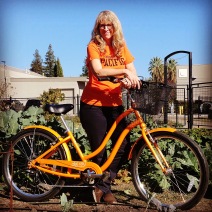by Tiffany Vu, University of the Pacific Student
 The words “seed catalogue” would bring to my mind a book, similar to what one might find at a department store, featuring seeds instead of outfits. How anyone could find a picture book of seeds interesting left me befuddled. To me, seeds were simply dried beans that grew into plants with a sprinkle of water and a handful of dirt. Imagine my surprise when I opened my first seed catalogue and learned how to properly care for seeds.
The words “seed catalogue” would bring to my mind a book, similar to what one might find at a department store, featuring seeds instead of outfits. How anyone could find a picture book of seeds interesting left me befuddled. To me, seeds were simply dried beans that grew into plants with a sprinkle of water and a handful of dirt. Imagine my surprise when I opened my first seed catalogue and learned how to properly care for seeds.
When I first received the Seed Savers Exchange catalogue, I was blown away. Opening the first pages, I was greeted with pictures and information of new additions to their collection as well as a note from Seed Savers Exchange about their process for selecting varieties to sell and their goal of sharing lesser-known varieties with other gardeners. As someone who has never cared about seeds and is tasked with planting a garden, I found the later section about seeds helpful in developing an idea of when and how to plant seeds. For example, beans are best planted in warm soil, while lettuce likes cooler temperatures; if the temperature outside is too cold, some seeds can be started indoors and be transplanted outside when the weather is warmer. The catalogue also mentioned a co-founder, Diane Ott Whealy, who likes to use a different approach when gardening and uses self-sowing seeds that will literally seed themselves when the time is right. Simply reading the introductory pages of this catalogue offered me some insight into how different people operate their gardens and showed me that gardening isn’t simply sticking a seed into the ground and hoping for the best.
Apart from the how-to’s of seed planting, the book was full of information about vegetables and fruits, some of which I was familiar with and others I had no idea existed. Flipping through the pages, I slowly realized that I had completely underestimated the diversity of fruits and vegetables. I had previously thought that the carrots I buy at the grocery store were the only kind of carrots available for everyone to buy and plant in gardens. Simply flipping to the page in the catalogue about carrots proved me wrong; varieties can range from short and stout to long and slender, as well as from red to orange to yellow. On the same page, there was an overview of companion planting that certain plants, like carrots, benefit from and a featured book that explains companion planting for those who would like to learn more about it.

Tiffany prepares to plant seeds in her Robb Garden plot
Every page turn uncovered new information as well as new plants. Each new variety brought new information pertaining to that plant and completely redefined every vegetable and fruit that I thought I knew. For those who would like endless tomatoes throughout the season, indeterminate tomatoes keep growing fruit while determinate tomato plants focus their energy on ripening theirs to give us a more plump, juicy crop. For the most bang for the buck, beets produce seeds that fuse together to form “seed balls” containing several seeds which will eventually produce seedlings that need to be thinned but can still be eaten. Learning about the unique characteristics of these plants gave me a different perspective on what growing plants looks like. Instead of picturing a ubiquitous cycle of seed to plant to fruit to seed, I can now see that each plant serves a purpose in the garden; some, like radishes, can be grown to serve as markers for slow-growing plants while others, like okra, produce fantastic flowers if left on the plant.
When it came time to start planting seeds, however, there was still much I did not know. After reading “What is a Seed?” in the book Saving Seeds, I was shocked to learn that seeds were, in a way, embryonic plants in dormancy. I was fascinated to learn about the different parts of a seed and how a seed is very much alive, metabolizing its endosperm by absorbing moisture from the air. When I previously looked at a seed, I could not wrap my head around the fact that a plant could come out of such a simple looking speck. Now, I can see how seeds, though they may look plain, are actually a miraculous way for plants to continue their legacy.
Seeds are rather picky when it comes to their environment. Different seeds have different temperature and light requirements, and the soil needs to be properly moistened and aerated for the seed to be able to come out of dormancy. In addition to these requirements, some seeds may need their seed coats to be broken in order to germinate. I imagine a seed to be a strange form of Goldilocks, looking for the right amount of moisture and light to, instead of fall asleep, wake up.
Seeds are not merely dried kernels, but rather hibernating plants waiting for the right time to wake up. It is no wonder why there are catalogues focused on tending to these sleeping creatures. Each has its own characteristics that bring different elements to a garden. After planting seeds and going through a seed catalogue, I now see planting seeds in a new light and am excited to see what comes next.
 I was first introduced to seeds when I was about 5 years old during Halloween time. My dad and I were carving pumpkins and he was keeping all the seeds from the insides of them. When I asked about it, he explained to me how they make new plants and eventually pumpkins. It was the way pumpkins had their children, he said. That kind of amazed me, because at five years old I didn’t have any concept of how food was grown. The idea of being able to grow some of the seeds that we collected was very exciting and all I could think about was of all the pumpkins I could grow.
I was first introduced to seeds when I was about 5 years old during Halloween time. My dad and I were carving pumpkins and he was keeping all the seeds from the insides of them. When I asked about it, he explained to me how they make new plants and eventually pumpkins. It was the way pumpkins had their children, he said. That kind of amazed me, because at five years old I didn’t have any concept of how food was grown. The idea of being able to grow some of the seeds that we collected was very exciting and all I could think about was of all the pumpkins I could grow.
 Some of my first memories are of a messy little garden in the side yard of the first home that I ever knew on Elizabeth Way. It was a small garden, probably no bigger than fifteen square feet. There were tomatoes, potatoes, broccoli, spices and other greens. My mom and I loved our little garden. I remember holding the seeds in my hands when my mom would let me help plant the next round of plants. I would wake up and run down the hall and push away the blinds on the sliding glass door just to look at the progress that our plants had made. I would also try and help water the plants too, but when you are two feet tall you can only reach so far back. I remember one time picking off a tomato and being told to take a bite out of it and absolutely disliking the taste. It gave my parents a good laugh and to this day I still do not like tomatoes. Our garden was beautiful, green, and full of life, unfortunately it’s been years since I have seen my first home on Elizabeth Way and our messy little garden.
Some of my first memories are of a messy little garden in the side yard of the first home that I ever knew on Elizabeth Way. It was a small garden, probably no bigger than fifteen square feet. There were tomatoes, potatoes, broccoli, spices and other greens. My mom and I loved our little garden. I remember holding the seeds in my hands when my mom would let me help plant the next round of plants. I would wake up and run down the hall and push away the blinds on the sliding glass door just to look at the progress that our plants had made. I would also try and help water the plants too, but when you are two feet tall you can only reach so far back. I remember one time picking off a tomato and being told to take a bite out of it and absolutely disliking the taste. It gave my parents a good laugh and to this day I still do not like tomatoes. Our garden was beautiful, green, and full of life, unfortunately it’s been years since I have seen my first home on Elizabeth Way and our messy little garden.
 I know you’re young, so you might not understand what I’m about to tell you, but I feel like you should know how I reacted when I held you in my hand for the first time. Holding you was something I’d never done before, and it felt strange to see you resting on my palm. I could barely see you, and I began to worry that you were gone because I dropped you. I was lucky, for I hadn’t dropped you; you were just hidden in the grove of my palm, watching as I panicked and tried to find you.
I know you’re young, so you might not understand what I’m about to tell you, but I feel like you should know how I reacted when I held you in my hand for the first time. Holding you was something I’d never done before, and it felt strange to see you resting on my palm. I could barely see you, and I began to worry that you were gone because I dropped you. I was lucky, for I hadn’t dropped you; you were just hidden in the grove of my palm, watching as I panicked and tried to find you.
 At University of the Pacific, one common experience that all first-year students share is to enroll in a series of courses called The Pacific Seminars, better known on campus as, simply, PACS. These seminars explore the question, “What is a good society?” while developing students’ critical thinking skills about significant personal, social, and political issues by means of extensive writing, reading, and class discussion. These are small-group classes where students get lots of individual attention from instructors and can form a close cohort with their classmates.
At University of the Pacific, one common experience that all first-year students share is to enroll in a series of courses called The Pacific Seminars, better known on campus as, simply, PACS. These seminars explore the question, “What is a good society?” while developing students’ critical thinking skills about significant personal, social, and political issues by means of extensive writing, reading, and class discussion. These are small-group classes where students get lots of individual attention from instructors and can form a close cohort with their classmates.